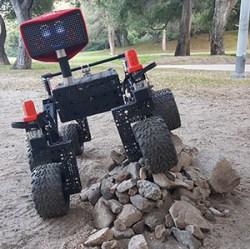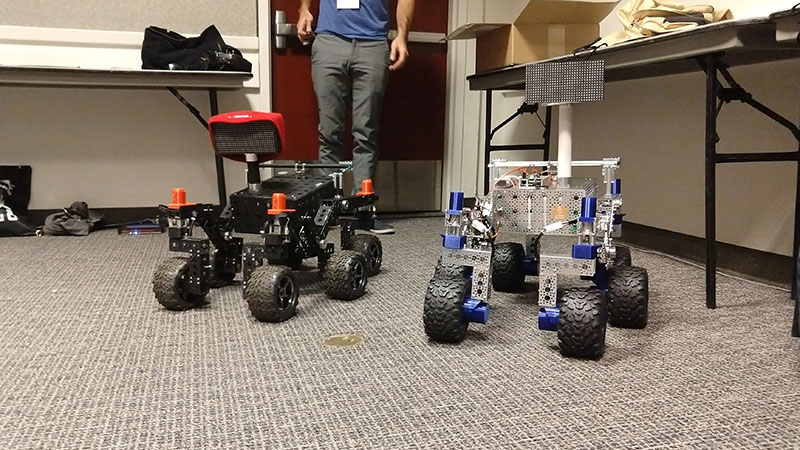Few things build excitement like going to space. It captures the imagination of young and old alike. Teachers love to leverage the latest space news to raise interest in their students, and space agencies are happy to provide resources to help. The latest in a long line of educator resources released by NASA is an Open Source Rover designed at Jet Propulsion Laboratory.
JPL is the birthplace of Mars rovers Sojourner, Spirit, Opportunity, and Curiosity. They’ve been researching robotic explorers for decades, so it’s no surprise they have many rovers running around. The open source rover’s direct predecessor is ROV-E, whose construction process closely followed procedures for engineering space flight hardware. This gave a team of early career engineers experience in the process before they built equipment destined for space. In addition to learning various roles within a team, they also learned to work with JPL resources like submitting orders to the machine shop to make ROV-E parts.


Once completed, ROV-E became a fixture at JPL public events and occasionally visits nearby schools as part of educational outreach programs. And inevitably a teacher at the school would ask “The kids love ROV-E! Can we make our own rover?” Since most schools don’t have 5-axis CNC machines or autoclaves to cure carbon fiber composites, the answer used to be “No.”
Until now.
To turn that “No” into a “Yes”, last summer a team of JPL interns were tasked to translate ROV-E into a rover that could be built by a class of high school students. Assembled from parts anyone could buy, using only tools that one would expect to find in a school shop. The project budget of $2,500 is a tiny fraction of ROV-E’s aerospace-grade price tag. While still on the high side for an individual, it could be reasonably compared to the expense of school group activities like a marching band or a sports team. After JPL interns delivered the initial prototype, the instructions were further refined and put through several beta test builds with people outside of JPL for additional feedback. (Disclosure: [Roger Cheng] was on one of the beta test teams.) Now it is available to all the teachers who have ever asked if they could build their own rover.
 For their money and effort, the school will end up with a rover that demonstrates the six-wheel rocker-bogie suspension system used by all JPL Mars rovers. The flexible structural construction pieces allow students to easily experiment with changing suspension layout, and see firsthand how their changes affect a rover’s ability to traverse terrain. The motor controllers leave plenty of headroom for the students to build sophisticated robot software, offering closed-loop control of velocity and position communicated over a shared serial bus. A Raspberry Pi 3 is recommended as the brains of the rover, because of its vast ecosystem of software tools and libraries with which to build that software.
For their money and effort, the school will end up with a rover that demonstrates the six-wheel rocker-bogie suspension system used by all JPL Mars rovers. The flexible structural construction pieces allow students to easily experiment with changing suspension layout, and see firsthand how their changes affect a rover’s ability to traverse terrain. The motor controllers leave plenty of headroom for the students to build sophisticated robot software, offering closed-loop control of velocity and position communicated over a shared serial bus. A Raspberry Pi 3 is recommended as the brains of the rover, because of its vast ecosystem of software tools and libraries with which to build that software.
Though designed for education, it is not limited to schools so any of us are free to build our own. In the spirit of open source, we are welcome to follow the instructions and build the rover as-is or devise improvements of our own design. There’s a web forum set up for community discussion and support, and don’t forget to add all of our rovers to the ranks on Hackaday.io! We love rovers of all kinds – from simple PVC pipes to mind-blowing LEGO creations.

















Street Legal, a requirement for most of us who do not own a piece of the Ponderosa…
The CAD files appear to be SolidWorks, a licenced and expensive product which sadly I don’t have. Are there any plain old STL files for this, that any 3D printer novice can load up in a slicer and take a look at?
It would have been way better if they made the .step files available.
https://github.com/nasa-jpl/open-source-rover/commit/2085922c095e4416857c7ff2e0f980719cd4d201
Easy enough to 3D print the joints for this type of suspension- one of our students did so. It was much cheaper than $2500.
So, you built the SpaceX version instead of the JPL version.
Cool. Still not as cool as Chinese, DJI sponsored/run, https://www.robomaster.com competition with almost 200 university teams participating each year in Shenzhen.
https://www.youtube.com/watch?v=AGeYeL5bMDk
Vods from 2018 edition https://www.twitch.tv/robomaster/videos/all
Rounds play like a MOBA, Bots are FPV only. Pilots often recruited from University e-sports teams ;o. Autoaim allowed if you can program it (a lot of teams do). Bonus damage can be unlocked by solving Image Recognition (MNIST numbers) challenge in the middle of arena. Most of winning/finalist team engineering members recruited on the spot by DJI and other Chinese companies.
Im surprised HaD never covered it :o